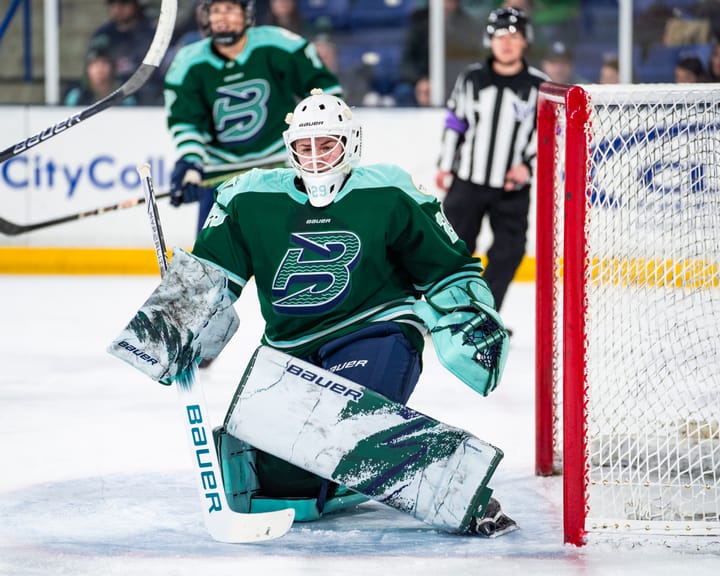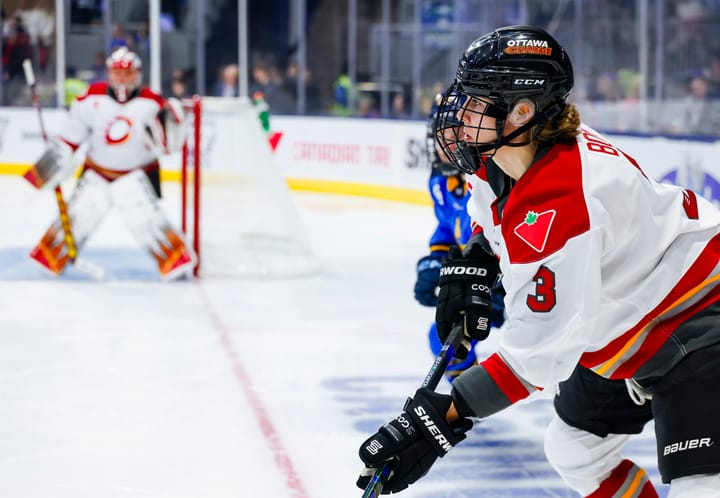Reader’s Report: Cold Day in the Sun
From the rink to the record shop, Sara Biren’s <em>Cold Day in the Sun </em>has got something for everyone.
If you’re looking to get your women’s hockey fix during this period of social distancing, but don’t want to get invested in a book you aren’t sure you’ll like? We’ve got you covered — reviewing every book from the list we compiled at the start of March.
We already reviewed Carrie Allen’s Michigan vs. The Boys. Now, we move on to a new selection: Sara Biren’s Cold Day in the Sun.
Title: Cold Day in the Sun
Author: Sara Biren
Rating: ⭐️ ⭐️ ⭐️ (3 stars)
Summary:
Holland Delviss has played hockey on boys’ teams since she was little — growing up with three hockey-playing brothers, it was what she was used to. That didn’t change even when she got to high school, where a girls’ team already existed. By her sophomore year, she’d earned a spot on her school’s varsity boys’ hockey roster...a spot a few naysayers in her town were insistent didn’t belong to her, despite the acceptance of her teammates.
In the middle of Holland’s junior season, her high school team is selected to be one of the five host cities for Minnesota’s annual HockeyFest, a state-wide event that attracts college and NHL scouts alike to the stands of teams that have traditionally flown under the radar. As the spotlight turns to Halcyon Lake, the focus is drawn away from the team and the town and onto the sole girl on the roster. Holland now has to juggle her time on the ice, her growing feelings for one of her teammates, and her writing career while shouldering the constant barrage of criticism and the burden of winning her team a spot on the national HockeyFest broadcast.
Who is your favorite character and why?
Honestly, my favorite character isn’t Holland herself (in fact, I found that I really didn’t like her character at all, but that’s not the point), but the captain of her team, Wes “Hot Sauce” Millard. Initially, Wes is described, through Holland’s eyes, as having it out for Holland — being harder on her in practices and games and dealing her an altogether unnecessary amount of snark and sass. As the story progresses, though, Wes becomes one of the most supportive people in Holland’s life, defending her from critics, opponents, and even a few teammates, and amplifying her voice when the attention turns to him.
That doesn’t mean he doesn’t have flaws, though. As Holland points out, he doesn’t understand what it’s like to be a girl playing hockey, let alone a girl on a team full of boys. He doesn’t realize the kind of hoops Holland has to jump through, all day and every day, to prove herself. Wes is the kind of character that tells Holland she doesn’t have to prove herself, that everyone knows she’s earned her spot on the roster — an admirable effort, but one that kind of misses the point. He makes consistently valiant efforts to try and make her feel comfortable (and ultimately succeeds, if Holland’s feelings are anything to go by), but as a reader, and as someone who has breathed women’s hockey for a good portion of my life, his attitude is heartbreakingly familiar in its cluelessness.
Where does the book take place?
Cold Day in the Sun takes place in a small town in Minnesota, a little ways north of St. Cloud, around a month before the 2018 Olympics in PyeongChang. While no female hockey players are mentioned by name, the prolific University of Minnesota Duluth Bulldogs and University of Minnesota Golden Gophers are referenced a couple of times, and the seven Minnesotans set to play at the upcoming Olympics are alluded to.
Something that’s a little frustrating is the frequent mention of male hockey players — namely, Zach Parise of the Minnesota Wild, who is Holland’s favorite player. Despite Holland playing on a boys’ team and the more widely publicized professional men’s league, you would think she might have — and name — some female idols. Long before the Minnesota Whitecaps were inducted into the NWHL, they functioned as an independent entity and had a number of extraordinary players on their roster during the 2017-2018 season (including 2020 NWHL Co-MVP and 2005-2006 Ms. Hockey Minnesota winner Allie Thunstrom, among others).
Even if the Whitecaps don’t exist in this universe, there are so many talented women’s college hockey players and Olympians from Minnesota. Just nine months prior to the start of the novel, the Minnesota Golden Gophers (a team that included Olympian and Minnesota native Kelly Pannek) made it to the Frozen Four.
Female hockey players already get virtually no media representation. The least a book, albeit a fictional one, about women’s hockey could do is name some of them.
What was the best part of the book and why?
The best parts of the book were undoubtedly the scenes that depicted actual hockey. Maybe it’s just because I was expecting a lot of hockey content going into the book, or because at this point, I’m starved for some action, but I was speeding through the typical-high-schooler parts pretty fast.
I also wasn’t super invested in Holland’s life. Her character wasn’t super developed, and as a reader, you were kind of just forced to piece together who each character was to her. Trying to figure out who each of her teammates was (considering they’re referenced both by real name and hockey nickname) while also trying to navigate her friends and extraneous characters was a little challenging.
Would you recommend this book to a friend?
It depends on what said friend is looking for. If you like romance and young adult fiction with a side of hockey, then sure; there are quite a few cute couple moments between Holland and her love interest. If you’re looking for a book about hockey and life with a side of romance, though, this isn’t the book for you. The hockey scenes are pretty few and far between, but they’re so well-written that I wish that there were more of them.
Favorite scene:
My favorite scene was definitely when Holland sat down with Wes’s little sister — a hockey player and fan herself — and explained to her that just because she played on a girls’ team didn’t make her any less than a girl who played on a boys’ team. Just because Holland grew up in a time when girls’ teams weren’t always accessible or available doesn’t mean that the girls who do have access to those teams should be looked down upon. This was one of the most important scenes in the book for me, because it really cemented why it’s important to create opportunities for girls and women in sports.
What comes next?
If you’re a hockey fan and an aspiring author, I would definitely recommend looking into the genre of sports fiction — especially women’s hockey fiction, but that’s just my personal preference. The world could always do with a few more solid sports fiction books, especially ones that are accurate, insightful, and have a hint of the truth in them, much like Cold Day in the Sun and Michigan vs. The Boys do. Get out there and tell the stories you’ve been itching to write.
Editor’s Note: If you’d like to purchase the book, we highly recommend shopping local. Even with local stores being closed due to the pandemic, many are offering delivery. You can also purchase ebooks and audio books from many local bookstores too. Find your local bookstore at Indie Books or Bookshop.





Comments ()